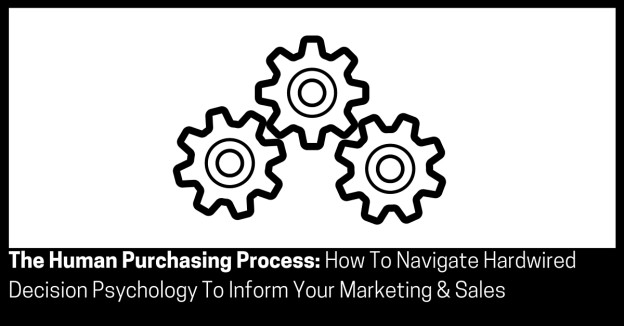Approximate read time: 18 minutes
What is your perception of sales and selling?
If you are like most people, your perception is probably that it’s hi-pressure and sleazy.
You hate doing it and you hate receiving it.
However, you probably also can’t quite put your finger on why this is the case.
…What makes it high-pressure or sleazy?
Why do people buy?
It can be seen as random and unpredictable, but it’s not.
Humans go through a variety of decisions before they make a purchase.
The following five steps outline them:
- STEP 1: Becoming aware of their needs;
- STEP 2: Determining if they want to change;
- STEP 3: Finding out about brands and products, services and solutions;
- STEP 4: Convincing themselves that one (ideally your) brand and products, services and solutions are the best for their needs; and
- STEP 5: Purchasing a product, service or solution.
This could be called the Solution Journey.
NOTE: Although an individual goes through these thoughts and decision, there are also various types of people who may block a prospect from making a buying decision.
These individual may be represented by one of the following eight categories of “Blockers”:
- User: they use the product, service or solution;
- Beneficiary: they benefit from the product, service or solution;
- Supporter: they are behind your brand;
- Influencer: they are someone a prospect listens to;
- Decision Maker: they make the buying decision;
- Purchaser: they hand over the purchase money; and
- Gatekeeper: they prevent your attempt to contact a decision maker or purchaser.
The movie The Wolf of Wall makes a great illustration and case study of all five Steps.
Down the deep rabbit hole we go….
In the last scene of that movie (http://youtu.be/vfU0Bu7qBTE), the main charter, Jordan Belfort, has the following conversations in a sales seminar.
He is teaching novice salespeople how to sell.
The conversations go like this:
- Jordan Belfort: “Sell me this pen.”
- Man 1: “It’s, it’s a-amazing pen. It’s a, for professionals, it’s a…”
- Jordan Belfort: “(Interrupting) Sell me this pen.”
- Man 2: “It’s a nice pen, you can, you can use the pen to, to write down thoughts from your life that can remem…”
- Jordan Belfort: “(Interrupting) Sell me… this pen.”
- Man 3: “Well this pen works and I personally…”
If you are on the ball, you can probably guess why Jordan keeps interrupting them…
…He interrupts them because they are fixated on features of the pen in question.
People don’t buy features.
People don’t even buy benefits.
People buy outcomes that move them away from pain or towards pleasure or both.
If fact, sometimes people just buy for the feeling of what a particular outcome would be like.
Now, if you watch a previous scene in the movie (http://youtu.be/VSObbMqKI4Y), Jordan asks the same question to his sales team:
- Jordan Belfort: “Sell me this pen.”
- Brad: “Why don’t you do me a favour and write your name down on that napkin for me?”
In the context of selling and sales, what do you notice about this clip?
Brad is not selling anything.
Brad does two things:
- He makes Jordan aware of his current situation, that is pain (he cannot write); and
- Of the potential situation that is away from pain (writing his name down).
Incidentally, Jordan isn’t even aware that he has a need until prompted.
Brad doesn’t sell features.
Brad doesn’t sell benefits.
Brad sells an outcome that moves Jordan away from pain and towards pleasure.
Brad can only do this if he knows Jordan (or any other suspect) is qualified, what their dreams, fears, problems, needs, mistakes are, and so on.
Brad does this within a split second without asking any questions.
In one fall-swoop he:
- Makes Jordan aware of his pain;
- Qualifies him;
- Find out his needs; and
- And offers a solution.
If you look at a simple marketing and sales pipeline:
- Lead Generation;
- Qualification;
- Needs Assessment;
- Solution Presentation;
- Addressing Concerns;
- Negotiation; and
- Close.
Brad covers them all in one sentence!
That is Jedi-level selling.
Most sales people (don’t worry, this is very normal) need to ask questions to determine if a prospect is qualified, what are their needs and concerns are, and then if there is a fit, start presenting a solution as though there may be a need that requires solving.
You can’t do any of this until your prospect is aware they even are in pain.
Lucky for you, most of the time, customers are aware of their pain first and start searching for a solution.
Selling is not just about buying – it’s about helping people get outcomes and results (sales, sponsorship, partnerships, romantic relationships, jobs, customers, ambassadors and so on). In my opinion, it is one of the most valuable things you can do in life.
This guide will give you the tools to achieve that.
Let’s start with a bit of buying psychology.
Customers purchase products, services or solutions when they want to move away from their current and towards a new situation – that being away from pain or towards pleasure, ideally in the fastest way possible.
Your product, service or solution is actually a barrier to moving customers away from pain or towards pleasure.
Let me explain…
Think about it this way; the most direct path for a customer would be a short two-step path:
- Current situation (pain); then
- New situation (pleasure).
With your product, service or solution, the path for a customer is actually a longer three-step path:
- Current situation;
- Your product, service or solution; then
- New situation.
This is the reason humans want magic pills or silver-bullet products, services or solutions, and want results yesterday!
Magic-pills or silver-bullets rarely exist, so you need to sell people what they want (two-step path), but you also have to give them what they need (three-step path).
The more you can speed up or automate your product, service or solution, the better.
You want to reduce the time and effort it takes to move from Step 1 to Step 3 to a minimum.
The fastest or most simple way you can move a customer away from pain or towards pleasure, the more value you add to them and the more you can charge for doing so via your product, service or solution.
The mechanism for this is your product, service or solution offer.
The communication for this is your marketing and sales, which will be addressed later in this guide.
Moving away from pain or towards pleasure is the outcome or benefit they want.
Customers don’t want features.
This is what Silicon Valley refers to as “product/market fit”.
Product/market fit, according to Marc Andresen, Cofounder of Netscape “means being in a good market with a product that can satisfy that market.”
Without further ado, let’s begin with…

1) Awareness Of Needs
…Step 1 is about prospects becoming aware of their dreams, fears, problems, needs, mistakes and so on.
In this step, the person goes from having no problem to a problem.
People are content with life.
Then something happens that they either want to move away from pain or move towards pleasure.
At this point, they become aware of their needs.
This could be triggered by something internal, or external, as in Jordan’s case above.
What follows is summarized in the following video: https://youtu.be/3Rs5LFetsk8.
Being able to determine a customer’s pains and gains means you will know the exact:
- Features;
- Benefits;
- Concerns;
- Price;
- Channels;
- Value proposition;
- Motivation;
- Urgency; and
- Product, service or solution names.
…To address in your offer and communication.
However, how do you build an irresistible offer, and how do you communicate that offer effectively?
Through market research.
Market research is success insurance!
What is market research?
Market research “is any organized effort to gather information about customers.”
Amazon.com uses a process called “working backward” for new product, service or solution creation.
Amazon’s CTO, Werner Vogel, said: “Start with your customer and work your way backward until you get to the minimum set of technology requirements to satisfy what you try to achieve.”
They write the press release, the Frequently Asked Questions and user manual all before the product, service or solution is created.
One of the best quotes I have read on this is by serial entrepreneur, Steve Blank:
“Marketing’s primary role at a startup is to drive sales. Marketing’s job is to make the VP of Sales the richest person in the company. How does marketing do that? Well, marketing’s job number one was to understand customers’ needs, desires, etc. and make sure engineering understood those as well”.
Marketing and sales require some fundamental elements such as:
- Qualifying;
- Credentials;
- Benefits;
- An offer;
- Call to action; and
- So on…
All of your market research must be related to your sales script, but it also should be related to the rest of your marketing and sales communication and offers.
Anything additional is superfluous.
You want to do as copywriter Robert Collier once said: “Enter into the conversation that your prospect is already having in their own mind”.
What?
Humans love homeostasis.
Homeostasis is a condition that remains stable and relatively constant.
Humans are twice as motivated to move away from pain then they are to move towards pleasure.
This makes sense when you consider Maslow’s Hierarchy Of Needs…
The upper needs, which not all humans can or want to achieve, are about seeking pleasure – things like gaining prestige – and the lower needs are about avoiding pain – things like having shelter from the harsh weather.
This is the logic behind purchases:
Someone has a pain or problem, which means they are not in homeostasis and they are outside their comfort zone.
As humans love homeostasis, they will do anything to return FAST to that stable and relatively constant condition.
Because of this, they are highly motivated to find a solution that will do this.
Any product, service or solution that communicates (through marketing and sales) that will provide the sought outcome or benefit (through the offer) will be purchased.
This lack of homeostasis also means they are highly willing to talk about it and will give you great insight into their worldview.
Your marketing and sales communication should mirror the exact phrases they use.
They should be saying, “This is exactly what I need!” when you communicate.
Human’s also love instant gratification and want to get back to their comfort zone FAST.
They see the value and not the opportunity cost (which I will discuss in-depth later), as they are solely focused on getting back to their comfort zone.
Most people think that we have a conscious thought and then act on it.
MRI scans actually show the reverse: we have an unconscious thought, we take action on it and seven seconds later we become conscious of that original unconscious thought.
This is called confabulation.
Confabulation is where we create a story and rationalize with logic after the fact.
Humans love to buy (biology, emotion, the past, stories) and hate being sold to (logic).
Loving to buy, actually means we are in homeostasis and back in our comfort zone and in “control”.
We get a boost of self-esteem.
Hating being sold to, actually means we have no pain or urgency, as we are being convinced to do something and we feel resentment.
Here are the exact steps to build an irresistible offer and how to communicate that offer effectively.
Gather a prospect list and ask the following six questions:
- “What are their biggest challenges, or what results are they trying to achieve?”;
- This will give you benefits;
- “What is the magic pill they think will achieve this?”;
- This will give you features and product, service or solution type;
- “If they could solve this immediately, how much would it be worth?”;
- This will give you price range;
- “Where and how are they looking to solve this?”;
- This will give you marketing and sales channels;
- “What are they considering buying?”;
- This will give you competition and value proposition;
- “What will happen if they don’t get this solved?”;
- This will give you motivation and concerns.
Of course, there are so many more questions to ask in market research, the exact details of how to do this are beyond the scope of this guide.
Other questions to ask include, external factors, such as demographics and, pains and gains, and internal factors such as product, service or solution promotional partners.
It is worth noting that you should not use surveys (quantitative results have a place, such as validating data, but it’s not here).
Do 40+ interviews.
Then look for common denominators and themes.
Add those common denominators and themes to your offer, marketing and sales pitch.
The groups of common denominators and themes also become your criteria for segmenting different parts of the market.
Of course, the exact details of how to do this are beyond the scope of this guide.
If prospects are not aware of their needs, they do not progress.
If prospects become aware of their needs, they progress to Step 2 – Determining Motivation…

2) Determining Motivation
…This step is about prospects determining if they are motivated to change (and buying).
In this step, the person goes from having a problem to looking for solutions that exist.
Think about it this way: if a prospect has become aware of their needs and they want to change a situation, then the next logical step for them is to evaluate this need against every other need they have and the resources they have access to.
This is an evaluation of opportunity costs.
An opportunity cost is the cost of an alternative course of action that must be forgone in order to pursue a certain action.
The resources they may call upon could be:
- Capital;
- Time;
- Effort;
- Attention; and
- Networks and connections;
- To name a select few…
The prospect’s motivation is also influenced by urgency or level of pain – think back to Maslow.
The higher the urgency or level of pain, the more motivated they are to get it solved (and buy).
Likewise, the lower the urgency or level of pain, the less motivated they are to get it solved (and buy).
Pretty simple.
The basic strategy here is to:
- Reduce their perceived risk in losing those resources in choosing your brand; and
- Increase the perceived urgency.
This could be done through the following:
- Asking questions to show you understand their situation;
- Giving away freebies;
- Showing your credibility through success stories, testimonials and case studies;
- Highlighting your credentials and expertise;
- Comparing price and other currencies;
- Offering product service or solution guarantees; and
- So on…
Of course, the exact details of how to do this are beyond the scope of this guide.
If prospects decide that this need is a low priority, they do not progress.
If prospects decide that this need is a high priority, they progress to Step 3 – Awareness Of Brands…

3) Awareness Of Brands
…This step is about prospects becoming aware of your brand in the market.
In this step, the person goes from knowing solutions that exist to knowing your brand exists.
Think about it this way: if a prospect decided that this needs important for them to solve, then the next logical step for them is to search for brands, products, services and solution, ideally they will search for your brand, product, service or solution.
For you, this is about marketing and generating leads.
Your role here is to make prospects aware of your brand, products, services and solutions.
If you communicate a marketing and sales pitch before that point, they won’t care or see it because it’s not important to them.
If you communicate a marketing and sales pitch after that point, they will care and see it as important to them.
In humans, this is called the Reticular Activating System.
The Reticular Activating System is the way a human brain controls what it gives attention to.
Only 2,000 pieces of information are processed by the brain per second out of 400 billion (400,000,000,000) pieces of information that they are exposed to each second.
This is the reason why advertising or constant marketing and sales communication works.
You, as a brand, have no idea where a prospect is at metaphorically or when a need arises, so using advertising or constant marketing and sales communication helps you catch prospects and customers at the right time for them.
One of the jobs of marketing is to help prospects become aware of their needs as well as be at the right place at the right time for when they do become aware of those needs.
Of course, the exact details of how to do this are beyond the scope of this guide.
If prospects do not become aware of your brand, they do not progress.
If prospects do become aware of your brand, they progress to Step 4 – Convincing Themselves…

4) Convincing Themselves
…This step is about prospects convincing themselves that a particular (hopefully yours) brand, product, services or solution is the best for solving their needs.
In this step, the person goes from knowing your brand exists to believing it will give them the benefits they seek.
As an example, when I was in Las Vegas a few years ago, it was hot, so I needed water.
Vendors were asking $9 per bottle.
Damn!
I was aware of my need, but it was not a compelling one to solve with a product, service or solution that I could get for free in any casino.
For you, this is about sales and converting leads to paying customers.
Your role here is to help them convince themselves using some of the following sales elements:
- Value proposition;
- Features;
- Benefits;
- Price;
- The offer;
- A call to action; and
- So on…
Of course, prospects are going to have some concerns or clarifications of misunderstandings and want to negotiate.
Here is a list of some common buying concerns:
- Have no need or willingness to pay;
- Have the wrong timing and it’s not urgent;
- Have no buying authority or ability to pay;
- Have no budget or ability to pay;
- Do not know what they get with the product, service or solution;
- Do not like or trust your brand;
- Do not believe (i.e. trust) the product, service or solution will work;
- Do not believe (i.e. trust) the product, service or solution will work for them;
- Do not think the product, service or solution is valuable; and
- Many, many more…
You need to be able to address these legitimate worries, if you want to have any chance of helping them convince themselves of your brand, product, services or solution.
This may not surprise you, but prospects also have certain Buying Personas.
These could be any of the following eight personas:
- Decisive: they want to make a decision;
- Collaborative: they want a consensus;
- Relationship: they want something that is friendly;
- Skeptical: they want facts;
- Gradual: that want to decide slowly;
- Change: they want to begin;
- Analytical: they want data; and
- Innovator: they want something that is creative.
Jung Personality Type gives another perspective on Attitudes, Functions, and Lifestyle Preference.
You can ask the following four questions to determine which of the 16 Jung Personality type prospects has:
- Do you prefer time alone or in groups?;
- Are you in the moment or constantly thinking about the future?;
- Do you use logic or gut feeling for decisions?; and
- Are you ordered or carefree?.
Of course, as the saying goes, the map is not the actual territory, and these are just a model of personas most people fit into for ease.
However, what you should take from this is that everyone is different in the way they like to communicate and how they comprehend information.
Communicating with them in the way you like to communicate is not a good strategy.
Once you know which personality type they have, you can read up on them here to see how they like to be communicated with when making a buying decision: http://www.16personalities.com/personality-types
Of course, the exact details of how to do this are beyond the scope of this guide.
If prospects do not convince themselves that your brand is the best for their needs, they do not progress.
If prospects do convince themselves that your brand is the best for their needs, they progress to Step 5 – purchasing a product, service or solution…

5) Purchasing A Product, Service Or Solution
…This step is fairly straight forward, as it is about prospects becoming customers through purchasing a product, service or solution, ideally from you.
In this step, the person goes from convincing themselves that your brand will give them the benefits they seek, to finally purchasing from your brand.
For you, this is about onboarding and delivering the product, service or solution.
If prospects do not purchase, they do not progress.
If prospects do purchase, they progress to being a customer.

Take Action
You made it…
You now have a solid plan for navigating human buying psychology to increase your marketing and sales.
That’s the full Human Buying Process, and it will be more than enough for you to get started on your own.
You can get the printed illustrated Process Map of this and 20 others for free, here
And if you’re serious about marketing and selling more, the logical next step is to contact me to help you do it yourself, have me do it with you, or have it all done for you.
This maybe the momentum you need to get great marketing and sales results.
Now let’s learn about The Market Research Process.
Or do you simply want more like this?
Join below to be notified immediately about new content and more. No annoying daily emails and no spam – just good content when it’s posted.

